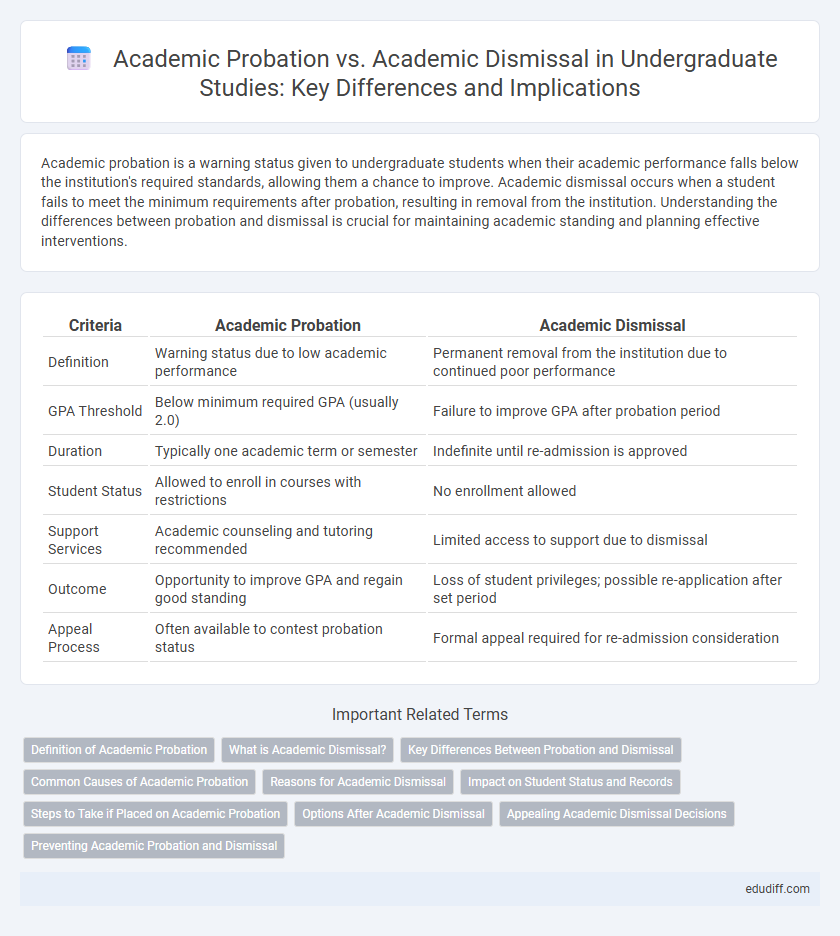Academic probation is a warning status given to undergraduate students when their academic performance falls below the institution's required standards, allowing them a chance to improve. Academic dismissal occurs when a student fails to meet the minimum requirements after probation, resulting in removal from the institution. Understanding the differences between probation and dismissal is crucial for maintaining academic standing and planning effective interventions.
Table of Comparison
| Criteria | Academic Probation | Academic Dismissal |
|---|---|---|
| Definition | Warning status due to low academic performance | Permanent removal from the institution due to continued poor performance |
| GPA Threshold | Below minimum required GPA (usually 2.0) | Failure to improve GPA after probation period |
| Duration | Typically one academic term or semester | Indefinite until re-admission is approved |
| Student Status | Allowed to enroll in courses with restrictions | No enrollment allowed |
| Support Services | Academic counseling and tutoring recommended | Limited access to support due to dismissal |
| Outcome | Opportunity to improve GPA and regain good standing | Loss of student privileges; possible re-application after set period |
| Appeal Process | Often available to contest probation status | Formal appeal required for re-admission consideration |
Definition of Academic Probation
Academic probation is a formal status assigned to undergraduate students whose academic performance falls below the institution's minimum GPA requirement, typically signifying a warning that they must improve their grades to continue their studies. This probationary period aims to provide students an opportunity to address academic deficiencies while receiving additional support such as tutoring or counseling. Failure to meet the required academic standards during probation often leads to academic dismissal, which is a more severe consequence involving removal from the university.
What is Academic Dismissal?
Academic dismissal refers to the formal removal of a student from an undergraduate program due to consistently poor academic performance, typically after multiple semesters on academic probation. This action results when a student fails to meet the minimum cumulative GPA or academic standards set by the institution. Academic dismissal means the student is no longer eligible to enroll in courses or receive credit until reinstatement procedures are successfully completed.
Key Differences Between Probation and Dismissal
Academic probation is a warning status for undergraduate students whose GPA falls below the institution's minimum requirement, allowing them a specified period to improve their academic performance. Academic dismissal occurs when students fail to meet probationary terms or achieve the required GPA after multiple evaluations, leading to their removal from the university. Probation offers a chance for remediation and support, while dismissal terminates enrollment due to persistent academic deficiencies.
Common Causes of Academic Probation
Common causes of academic probation include maintaining a GPA below the institution's required minimum, failing to complete a sufficient number of credits each semester, and poor performance in critical courses within a student's major. Academic probation serves as a warning and provides students with an opportunity to improve their academic standing before facing more severe consequences. Repeated failure to address these issues can lead to academic dismissal, which removes the student from the institution permanently.
Reasons for Academic Dismissal
Academic dismissal primarily occurs due to consistently failing to meet the minimum academic standards set by an institution, often after repeated warnings and periods of academic probation. This includes low cumulative GPA below the required threshold, failure to complete required credit hours, or inadequate progress toward degree completion. Institutions may also dismiss students for violations related to academic integrity or failure to adhere to established academic policies.
Impact on Student Status and Records
Academic probation places students on a temporary warning status, signaling the need for improved performance while keeping their enrollment active. Academic dismissal results in the termination of student status, often requiring reapplication for readmission if allowed. Both statuses are recorded on academic transcripts, with probation indicating a warning and dismissal reflecting a more severe interruption in academic progress.
Steps to Take if Placed on Academic Probation
Students placed on academic probation should immediately consult their academic advisor to develop a personalized plan for improving their grades and meeting university standards. Utilizing campus resources such as tutoring centers, study groups, and time management workshops can significantly enhance academic performance. Maintaining regular communication with professors and monitoring academic progress closely is crucial to avoid escalation to academic dismissal.
Options After Academic Dismissal
After academic dismissal, students often have options such as appealing the decision, enrolling in a different program, or taking courses at a community college to improve their academic record. Some institutions offer re-admission after a specified waiting period or require completion of a probation plan with improved academic performance. Seeking academic advising and utilizing support services can also help students successfully return and continue their undergraduate studies.
Appealing Academic Dismissal Decisions
Appealing academic dismissal decisions requires submitting a formal written appeal detailing extenuating circumstances and supporting documentation such as medical records or letters of recommendation. Universities often have strict deadlines and specific procedures for appeals, which may include a hearing or review by an academic committee. Success in appealing dismissal decisions can lead to reinstatement, often with probationary conditions to ensure academic progress.
Preventing Academic Probation and Dismissal
Maintaining a minimum GPA of 2.0 and meeting credit completion requirements are critical to prevent academic probation and dismissal. Utilizing campus resources such as tutoring centers, academic advising, and time management workshops enhances student performance and reduces risk of academic failure. Early intervention through regular progress monitoring and seeking support when difficulties arise helps maintain satisfactory academic progress and avoid probationary status.
Academic Probation vs Academic Dismissal Infographic

 edudiff.com
edudiff.com